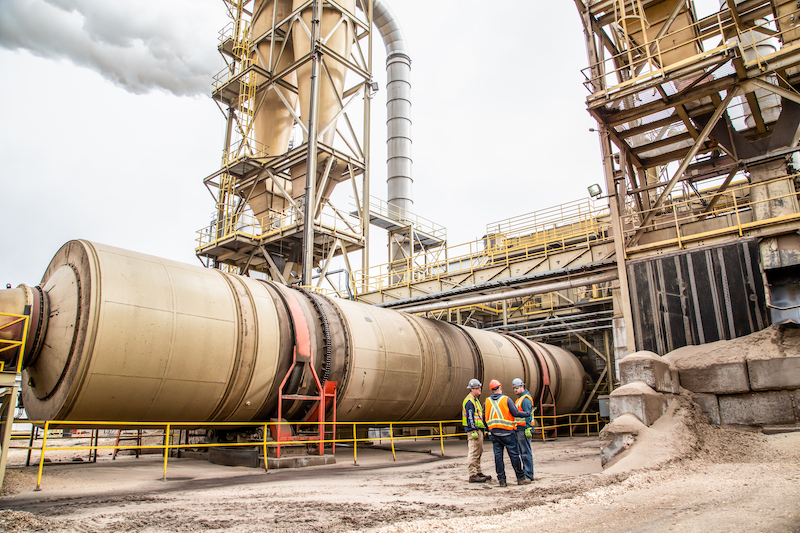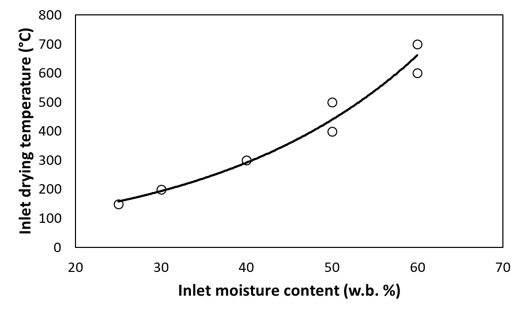
How to lower the chance of rotary drum dryer fires
March 11, 2020
By Hamid Rezaei, Fahimeh Yazdanpanah, C. Jim Lim, Anthony Lau, Shahab Sokhansanj
 Rotary drum dryer equipment with an approximate length of 15 meters and a diameter of four meters to reduce the moisture of biomass feedstock down to five-seven per cent. The quality of produced pellets depends on the biomass moisture content and the drying process helps to create an efficient pelletization process. Photo courtesy WPAC.
Rotary drum dryer equipment with an approximate length of 15 meters and a diameter of four meters to reduce the moisture of biomass feedstock down to five-seven per cent. The quality of produced pellets depends on the biomass moisture content and the drying process helps to create an efficient pelletization process. Photo courtesy WPAC. Biomass feedstock drying is a key operation for producing durable and storage stable pellets. The operation reduces the average moisture content from about 50 per cent (wet mass basis) to five – seven per cent. The rotary drum dryer is the most common type of dryer used for this task [1, 2]. Depending on the moisture content of the biomass, the operating temperature for such dryers is around 300-600 C [3]. Such a high temperature maximizes the moisture evaporation rate and shortens the residence time of biomass in the drum. The revolving drum tumbles the wet biomass as the drying air passes through the dryer. A series of lifters in the drum pick up the material and drop it through the air stream to maximize heat transfer efficiency. Heavy particles remain in the drum for a longer time while smaller and lighter particles pass through faster.
The source of heat in a dryer is either ‘direct’ or ‘indirect.’ In direct heating, the hot gases from the combustion process are diluted with cold air and fed directly to the dryer. The source of cold air is either atmospheric fresh air or recirculating reduced oxygen from the exhaust side of the dryer. In some indirect heated dryers, the rotating drum is enclosed in a heated chamber. Contact with the heated drum’s shell dries the material. Indirect dryers are less efficient compared to their direct heated dryers but have lesser entrainment of fine materials. Fire incidents in indirect dryers are much less frequent than the fire incidents in direct fire dryers. The potential for traveling combusted materials along the drum is lower in indirect dryers. Currently, the direct heated rotary drum dryer is the most popular type of dryer in the pellet industry.
The rotary drum dryer that is used for drying fresh green crop (e.g. alfalfa) operates at a much higher temperature of up to 850 C. The recommended moisture content of the input biomass is about 50 per cent. Figure 2 shows the simulated drying temperature versus inlet moisture content of biomass. The biomass, initially at 60 per cent moisture content, requires a drum temperature of 700 C in order to dry to five-seven per cent moisture content. The high temperature of the dryer might be operationally acceptable for many materials that are not fibrous like most agricultural and forest residues. The fibrous materials tend to burn easier than non-fibrous material.

Figure 1 – Inlet drying temperature versus the inlet moisture content [4]. The dryer’s back-loop control system controls the inlet hot gas temperature to achieve the final five-seven per cent moisture content.
In 1990, researchers conducted a series of experiments to test the flammability of fractions of chopped alfalfa (stems, leaves and a whole mixture) in a rotary drum dryer operating between 300-800 C. That study showed that the material started to burn even before its moisture was completely evaporated. The results surprisingly showed that the partial drying period took only 15 to 45 seconds, depending on the material density. This time is much shorter than the residence time of biomass in an industrial rotary drum dryer.
In 2018, a team of researchers at the University of British Columbia (UBC)’s Biomass and Bioenergy Research Group (BBRG) initiated research on “Reasons of Fire in Rotary Drum Dryers in Pellet and Bioenergy Industries.” The group hypothesized that fire incidents in rotary drum dryers are due to two possible sources: (1) combustion of flammable gases emitting from the material during drying, and (2) burning biomass itself when passing through the dryer. The UBC team realizes that the fire incident is all about the probability, not certainty. This means the research focuses on the parameters that elevate the probability of fire during the process.
The initial hypothesis in this research was that the newly added biomass species emit a higher level of combustible gases than the blends of SPF during drying. The elevated concentration of combustible gases falls in the flammable zone. The hypothesis was tested by measuring the concentration of combustible gases emitted from heated Western red cedar (WRC) and SPF. Flammability analysis conducted according to ISO 10156 Standard showed that the combustible gases in WRC and SPF samples did not reach the required concentration level to be flammable.
In a concurrent flow rotary dryer, water evaporates from the moist material when it comes in contact with hot air. This is supposed to keep the surface temperature of the particles below the burning point, but it requires a perfect mixing of air and particles. If this perfect mixing does not happen and some particles dry fast and remain in contact with heated air, these particles will burn. Such a significant difference increases the probability of fire or partial combustion of biomass in the drum. Our laboratory measurements have identified the burning temperature of various woody biomass to be between 170-190 C. This temperature is much lower than the input temperature of the rotary dryers (300-600 C).
Unfortunately, the space inside the rotary drum dryer is not easily accessible and direct measurement of profiles of the hot air temperature and biomass residence time in the drum, and biomass moisture content alongside the drum, is not practical without shutting down the operation. At UBC, we are currently focused on investigating the relationship between the drying gas temperature, material size and moisture content and the critical time at which the moist biomass starts to burn at a range of drying gas temperatures. Such technical information helps us understand the role of each parameter on the initiation of fire in the rotary drum dryer and make constructive decisions to minimize the fire probability in the system. The experimental efforts to clarify moist biomass’ behaviour in the harsh thermal environment of a rotary dryer is accompanied by complex numerical modeling to simulate the flow of air and biomass material in the drum. The purpose of the model is to quantify the interaction between flowing air and biomass material and evaluate the mixing of the biomass in the drum.
Rotary drum dryers are by far the most popular systems for drying fibrous and leafy material. The dryers are efficient in terms of heat transfer and uniformity of the final moisture content, with an immediate response to changes in incoming moistures. The dryers are generally cheaper than other dryer types and much easier to operate. None of the other dryer types, especially belt dryers, come close to the adaptability of rotary drum dryers. But the problem with incidences of fires needs to be addressed, especially for fibrous forestry and agricultural materials. UBC researchers suggest the following strategies to reduce the potential of fires in rotary drum dryers:
- Screen off the small particles to bypass the dryer
- Reduce the inlet temperature by increasing the length of the dryer
- Employ indirect heating schemes
- Increase distance between the firebox (burner) and the drum
References
[1] Jensen, P. D.; Temmerman, M.; Westborg, S. Internal Particle Size Distribution of Biofuel Pellets. Fuel, 2011, 90 (3), 980–986. dx.doi.org/10.1016/j.fuel.2010.11.029.
[2] Rezaei, H. Physical and Thermal Characterization of Ground Wood Chip and Ground Wood Pellet Particles. Ph.D. Dissertation, University of British Columbia (UBC), 2017.
[3] Fagernäs, L.; Brammer, J.; Wilén, C.; Lauer, M.; Verhoeff, F. Drying of Biomass for Second Generation Synfuel Production. Biomass and Bioenergy, 2010, 34 (9), 1267–1277. doi.org/10.1016/j.biombioe.2010.04.005.
[4] Sokhansanj, S.; C. Wood, H.; S. Venkatesan., V. Simulation of Thermal Disinfection of Hay in Rotary Drum Dryers. Transactions of the ASAE, 1990, 33 (5). doi.org/10.13031/2013.31522.
Hamid Rezaei, Fahimeh Yazdanpanah, C. Jim Lim, Anthony Lau, Shahab Sokhansanj are members of the Biomass and Bioenergy Research Group (BBRG) at the University of British Columbia.
Print this page